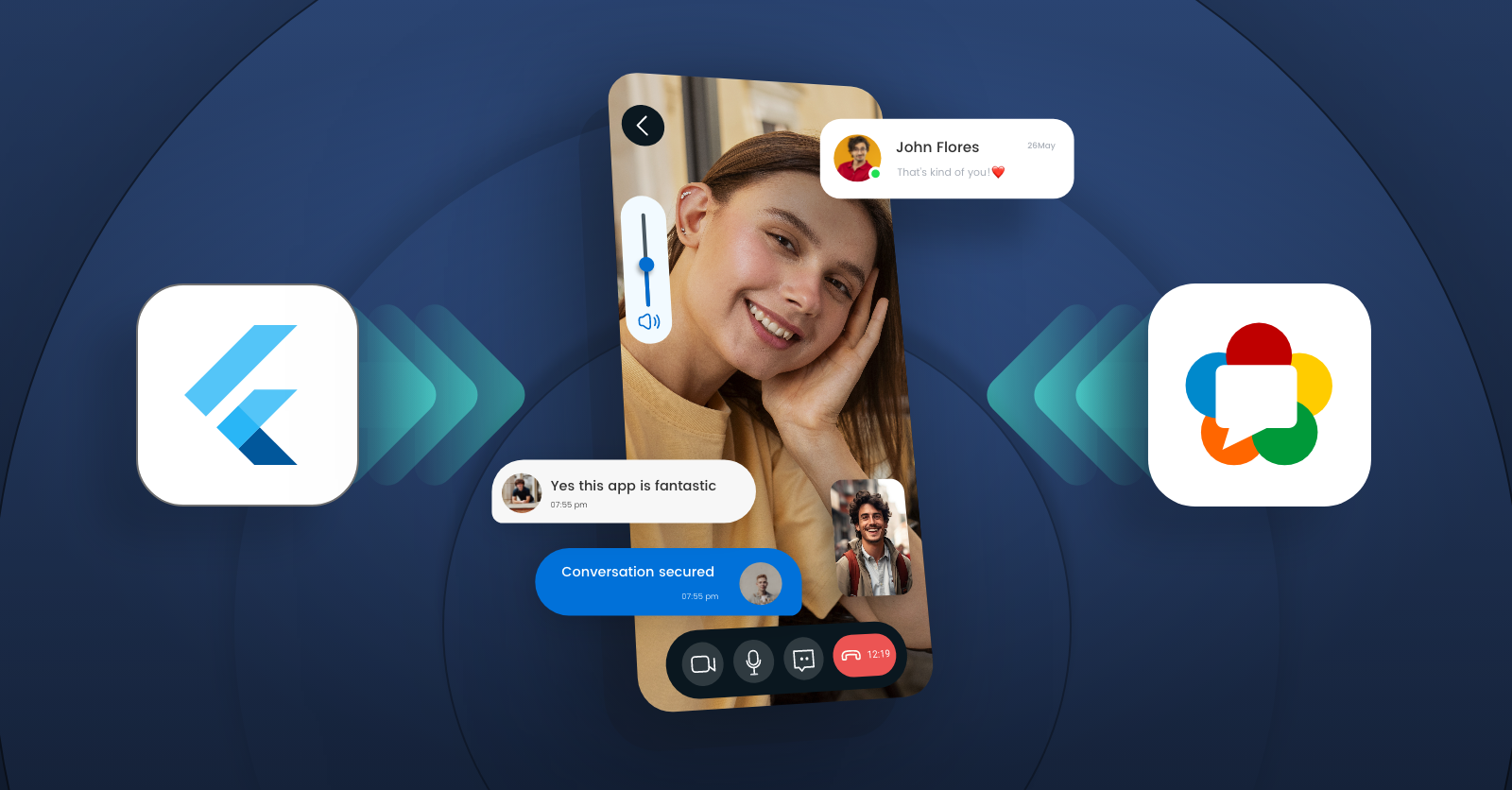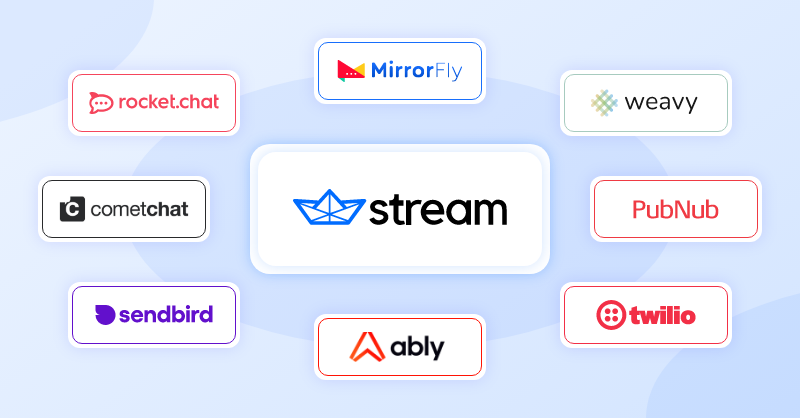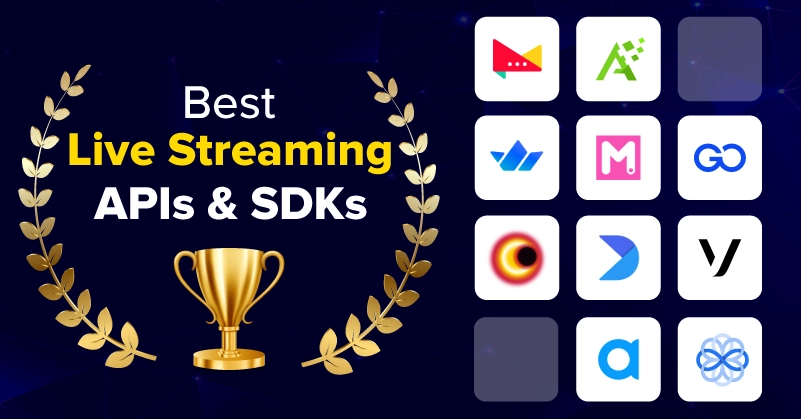7 Best Self Hosted Video Conferencing APIs & SDKs For 2025
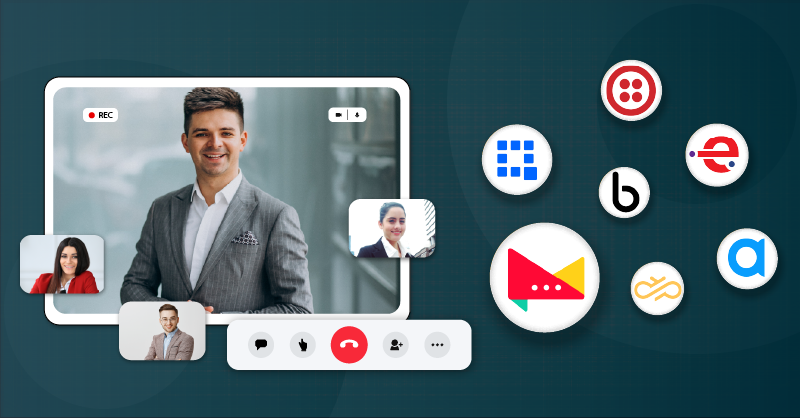
Worried about users uninstalling your app because they are frustrated with lagging calls? Choosing the best video conferencing APIs & SDKs can be the game-changer you need!
Last year, I secured an app development project where my client asked me to build a telemedicine app with video conferencing, for their medical consultation business.
Just like any regular developer, I took it up, super-excited to build every inch of the app, all by myself, right from scratch.
And that is one of the decisions I regret till date.
Here are the challenges I faced during this project:
1.Slow-down of Development ⌛
To build a video conferencing app, I needed to implement WebRTC, a technology that is solely responsible for peer-to-peer video, audio, and data sharing.
I spent weeks grasping the basics, configuring media servers, and handling signaling. This consumed a lot of time and slowed down my development timeline.
2. Video & Audio Performance 😥
Somehow, I managed to build and deploy the app after a lot of technical struggles. Now was the moment of truth.
During a test call between a doctor and a patient in different geographic locations, we noticed delays in video and audio transmission.
And the third challenge came as a surprise to me!
3. Security & Privacy Compliances 🔒
We all know that medical consultations involve sensitive conversations. I had the responsibility to secure the video conferences while complying with HIPAA regulations. But that was not ALL!
The app was built for doctors and patients around the world, and it must comply with all the regional compliance requirements to make it legally available for use. So, I had to work on custom implementations that could not be hacked.
This challenging parts of the project pushed me to look for solutions and just after the successful deployment of the app, I found something I will never miss out in my next projects – Using Video Conferencing API.
Table of Contents
What is Video Conferencing API?
A video conferencing API is a plug-and-play component that acts as a software interface for adding real-time video and audio communication to an existing web or mobile app.
In my next projects, I went on to use a pre-built video conferencing API that helped me embed highly interactive video communication features to the apps, within just a few minutes.
All I did was,
- Get the API from a provider
- Integrate it to my app and
- Deploy it
Which was 10x faster and better than how I built apps from scratch.
While I was able to use a virtual meeting software for my project, the hunt for the API took a bit of my time.
Seriously, there are a lot of options out there, and picking the right one is very important. So, I just curated a list for you so you could review them and choose the best video conferencing API for your project.
7 Best White Label Video Conferencing APIs & SDKs in 2025
The Top 7 Best self hosted Video Conferencing API service providers are 1.MirrorFly, 2.Banuba, 3.Agora, 4.Twilio, 5.QuickBlox, 6.EnableX, 7.Sinch, and others.
1. MirrorFly – Embed Video Conferencing API & SDK Into Your Website
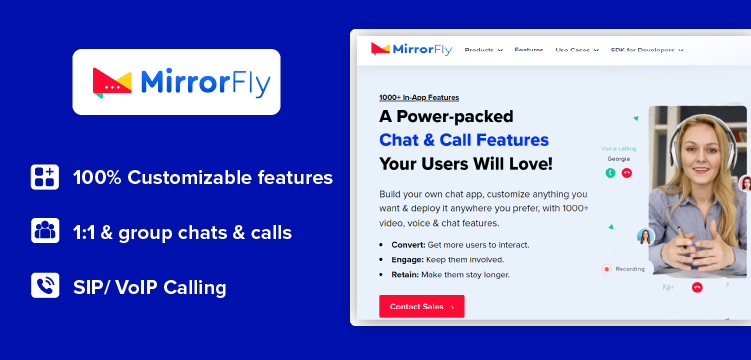
MirrorFly is a leading in-app communication provider that offers 1000+ customizable video, voice, and chat features. Most developers prefer the MirrorFly white label video conferencing solution for its ease of use and rich set of features.
Plus, you can get complete access to MirrorFly’s source code. Which means, you can customize it as much as you want, as per your business requirements.
Core Features Of MirrorFly
- 100% white label video calling features
- 1:1 and group chats & calls
- SIP/ VoIP Calling
- Topic-based chat & calls
- Push notifications
- Online presence indicators
- Join via call link
- Call history
- Call scheduling
- Call data export
Why MirrorFly?
The best part of using MirrorFly is, you can deploy it anywhere, literally, anywhere, on your own data centers or on MirrorFly’s cloud server.
2. Banuba – Embed Remote Meeting Solution to Any App
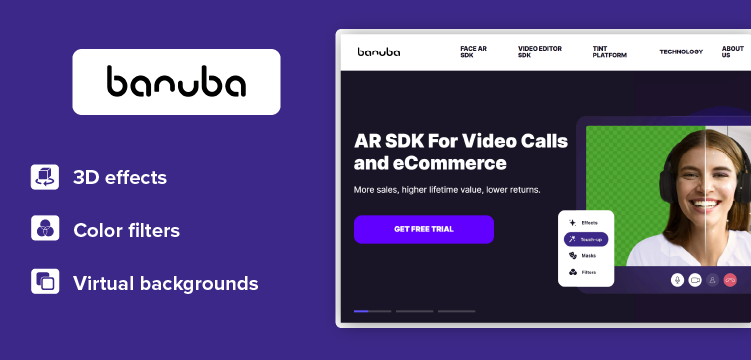
Banuba offers a Self hosted chat SDK that boosts engagement with highly scalable video conferencing features. They help engage users, reduce camera shyness, and add an extra layer of fun elements.
Banuba Face AR SDK has a native extension for Agora. It can also be integrated with Banuba Video Editor SDK that can process pre-shot videos.
Features and functionalities
- 3D effects
- Color filters
- Virtual backgrounds
- Avatars
- Triggers
- Virtual makeup
Use cases
- E-commerce
- Lifestyle apps
- Social media
- E-learning
Why Banuba?
The SDK doesn’t collect or store any user information, making it secure by design.
3. Agora – Integrate Web Conference Solution to Website
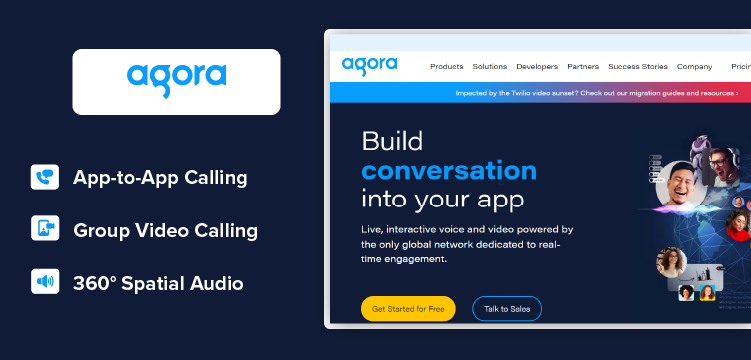
Agora is a robust tool that offers real-time communication SDKs for your websites. It increases user engagement with real-time voice and messaging, remote meeting, and live streaming products.
The company is currently working to develop interesting features that forge real-time connections in the virtual world. Many well-known brands, including Hallo and Talkspace, have chosen Agora as their real-time communication partner.
Features and Functionality:
- App-to-App Calling
- Group Video Calling
- 360° Spatial Audio
- Draw Whiteboard
- Live Streaming Chat
And considerably more.
Why Agora?
Agora stands out from its competitors for its cross-platform support for native mobile apps and websites. Plus, it has user-friendly functionalities and a highly- active support team.
Looking to Recreate your Existing Agora Platform?
4. Twilio – Developer-friendly Remote Meeting SDK
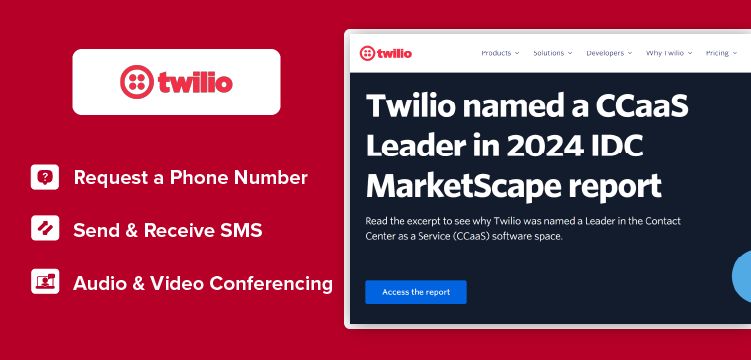
Twilio is a cloud communication platform that is ideal for developing global online virtual meeting applications for mobile via APIs. It enables mobile app developers to make and receive phone calls using video APIs.
It encourages the development of open-source solution that allow businesses to configure phone numbers for call routing. The design of Twilio API is simple, reliable, and well-documented.
Twilio also offers a web service called ‘In the Cloud,’ allowing developers to integrate real-time phone calls into their apps.
Features and Functionality:
Twilio Supports Programmatically
- Request a Phone Number
- Send and Receive SMS
- Audio and Virtual Meeting
- Make Outbound and Receive Inbound Phone Calls
- Call Monitoring and Call Routing
- Transcribe Phone Calls
And considerably more.
Why Twilio?
In short, Twilio API integration is the most cost-effective way to grow a business by leveraging a telephone system.
Update:
Twilio Video is shutting down, and you may need to migrate to other providers before December 5, 2024.
Read the full details of Twilio Video Shutdown here.
5. QuickBlox – The White label Virtual Meeting Software
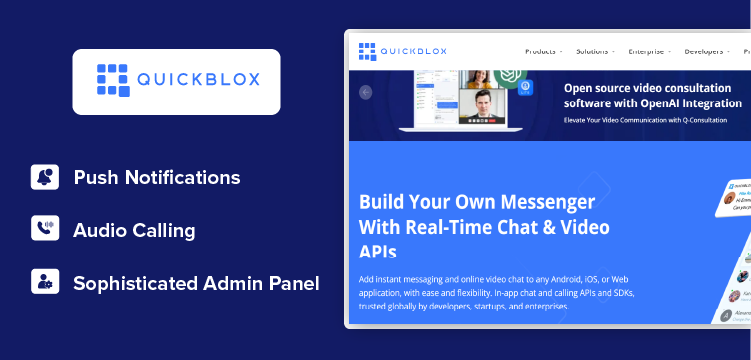
QuickBlox utilizes the Extensible Messaging and Presence Protocol (XMPP) for its chat connections. Its services are metered based on community usage. Also, it provides access to core files and can be fully customized to match the needs of your project. Quickblox also creates commercially available communication tools for app developers. It is one of the most widely used APIs on social networking platforms and enterprise apps.
Features and Functionality:
- Push Notifications
- Audio Calling
- Sophisticated Admin Panel
- Security Encryptions
And considerably more.
Why Quickblox?
When it comes to project setup, you can find helpful code samples for a wide range of technologies. These codes can save you both time and money.
6. EnableX – Easily Embed OnPremise Remote Meeting Solution
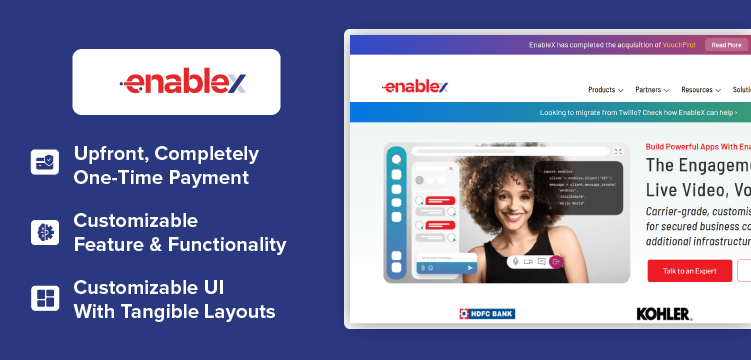
Enablex is a cloud-based real-time communication platform designed for developers and businesses of all sizes. Their video conferencing SDK toolkits are easy to integrate into any iOS, Android, or web app.
Apart from basic functionalities, this in-app communication platform offers a wide range of API add-ons for pre-processing and post-processing real-time and in-session data collected during the session.
Features and Functionality:
- Upfront, Completely One-Time Payment
- Customizable for Any Feature and Functionality
- Customizable UI With Tangible Layouts
- Screen-Sharing & File Sharing
- End-to-End Encryption
Why Enablex?
Enablex, the video solution, aids in the development of HD video-enabled Android, iOS, and Web applications.
Their feature-rich SDKs enable users to have one-on-one and group video calls. They also offer a live interactive broadcast feature that allows you to relay content across devices.
7. Sinch – Online Remote Meeting Software for Mobile & Web
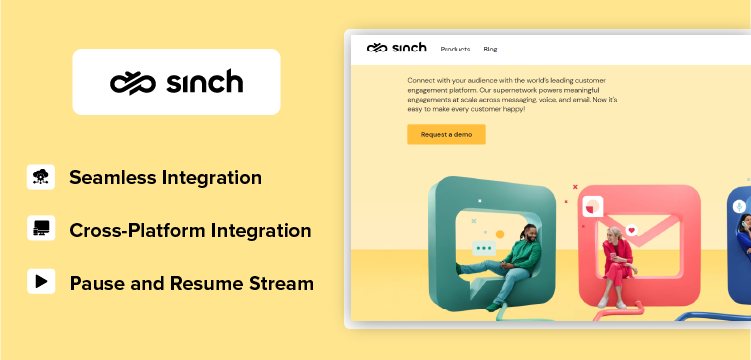
When it comes to cost-effectiveness, VoIP-based Sinch comes out on top. The video quality rate starts as low as $0.003 per minute. It is considered the most cost-effective teleconferencing solution on the market.
On top of that, they offer 2500 free calling minutes per month. Their core principle is simplicity, which drives them to create feature-rich SDKs.
They are compatible with iOS, Android, and web applications that are simple to install and use. Developers can now embed video calls without any kind of hidden cost, and you can pay right off the bat.
Features and Functionality:
- Seamless Integration
- Cross-Platform Integration
- Pause and Resume Stream
- Extensive Platform Documentation
- Data Calling
Why Sinch?
The platform is built on VoIP and WebRTC to power the products. Their list of collaborations is also quite impressive- Truecaller, Tango, Uber, and a slew of others.
Key Benefits Of Buying Vs. Building A Video Conferencing API
Which company would you choose? A company that just delivers products, or a company that creates the best customer experience.
Obviously the latter, right?
Plenty of statistics support this fact. However, building such apps is not as easy as it sounds. It requires you to spend a lot of money on reliable resources.
But the trick is, you just need to invest in a pre-built API, customize the communication features for your users, and let the API provider handle all the maintenance and bug fixes.
1. Be Compliant Everywhere
‘Theft of conversation’ is the last thing you’ll need to face on your app. While you care about it as a developer, the governmental organizations already have a set of compliances that your app must abide with, just to ensure that your users conversations are safe.
As mentioned at the start of this blog, it is not easy to build an app that complies with all the privacy regulations. Above this, complying with region-based regulations can be a hick.
But you can easily check this item off your list, by using a video-conferencing API that comes compliant with all the necessary regulations.
2. Grow Your User Base Without Limits
You will not have the same volume of app usage all the time. Sometimes, you are going to witness millions of users using your app concurrently, and other times, its going to be only a few.
The scale of app use may vary from time to time as the industry trend fluctuates. Facing this situation requires constructing a reliable backend infrastructure, which eventually requires you to spend a fortune.
But what if I tell you, you need not take all the risks yourself.
You can safely invest in a video conferencing API that takes care of all the auto-scaling your video chat app system needs.
Features You Must Never Compromise In A Video Conferencing API
- HD Conferencing: Make sure that the API is capable of delivering the best quality of video conferencing, even if the volume of users goes off the roof.
- Share Huge Files: Your users are going to share a lot of files with other users, some of which may be of huge size. The web meeting solution must not leave users hanging on the ‘loading’ screen. Be it any size, or format of file, the API must smoothly send/ receive them.
- Join Via Meeting Link: Your app users may have to send meeting invites to other users who might not have your app installed. In such cases, your users can create and share a meeting link with which they can connect to the conference seamlessly.
- Schedule Calendar: Video conferencing mostly involves business meetings that need to be scheduled at specific times and on certain days. Go for the API that has the ‘schedule conference/ meeting’ feature.
- Call History: Your users will need a backup of their call details with clients or teams, and this detail must be accessible on any device you log into.
- SIP/ VoIP Calling: Connect your users via HD video conferencing over an internet connection, instead of the traditional (and complex) phone lines.
- Custom Security: Safeguarding user conversations can be done on different levels. One app requires just regular encryption, and the other may require layers of encryption. A video conferencing API must let you customize these encryptions as per the demands of each business.
Your Checklist For Choosing The Right Video Conferencing API
- 100% Customization
You are going for a virtual meeting software to make your app development easier and quicker. What if the API you choose does not allow you to personalize the features and functionalities.
This may add headaches to your app’s development process. This is a reason why you must choose 100% customizable APIs, so that you can build the exact app that you are aiming for.
- Feature-richness
One of the challenges you might face with a self hosted Video conferencing software is that you may not have all the features your business requires.
This is why you need to choose an API that balances features and quality equally.
- Unlimited Calling
Imagine a message popping on your users’ UI “You’ve reached your call quota limit. You will not be able to make any more calls for the day.”
This would be one frustrating reason why your user may immediately hit the ‘uninstall’ button.
Keeping this is mind, you need to choose a remote meeting solution that allows users to make and receive calls without any limitations.
- Cross-platform Support
A user can make a call from his Android device to another user’s iPhone. Your Video Conferencing API must be able to connect both these devices, although they operate on different platforms.
- Integration Support
Your app users are going to need more from your app beyond video conferencing. This could also be a reason why they’ll stick with your app for a long time.
It would be better if the API supported integration with other third-party extensions/ plugins that your app users use on a daily basis.
- White-labeling
Have you noticed a few apps that mention the logo or name of a third-party business, which supported them in building the app? Most business owners do not prefer this, because it may tamper with branding projection.
Make sure you can add your own logo, colors, and branding elements, without mentioning the API provider’s name.
- Uptime SLA
For businesses, your app must not go down, even for a few seconds. This may lead to huge monetary loss or their customers might lose trust on the business.
Choose a web conferencing software that has an uptime SLA above 99%
- Low Latency
No one likes lags in a video call when they are particularly engaged in an important discussion. Your virtual meeting solution must ensure minimum packet loss and delay in data transmission so that, in real-time, your users will have super-smooth video conferencing.
- Tech Support
You can’t be stuck in the middle of the video API integration, left abandoned. You’ll need an easy way to connect with the provider anytime you need help with the API.
So, choose a provider who can help you out 24/7 or who can commit to building the entire app for your business.
- Adaptive Frame Bitrate
Be it factors like network conditions of the users, performance of user devices, or high volume of usage, your video API must automatically adjust the call to the best quality.
This way, you can keep conversations going no matter what!
Ready to Build Your Next Big App With a Video Conferencing API?
It’s great that you’ve come this far to learn about Video Conferencing APIs. Now, you have a list of APIs that you can choose from.
But if you are still confused, I would recommend that you choose MirrorFly as your first choice.
Why?
MirrorFly is the only in-app communication provider that lets you build your own web conference apps with 1000+ white label features.
Plus, you have the flexibility to deploy your app on your own data centers/cloud, or on MirrorFly’s dedicated servers.
I’ve been using MirrorFly for my projects, and the best part is that I was able to access their full source code without any limitations. It covers all that I need for building apps for any industry, just as mentioned in the blog.
Now, what are you waiting for? Sign up for MirrorFly and start building any kind of app with video conferencing features.
Get Started with MirrorFly’s Secure Video Conferencing Features
Drive 1+ billions of conversations on your apps with highly secure 1000+ real-time Communication Features.
Request Demo200+ Happy Clients
Topic-based Chat
Multi-tenancy Support

Frequently Asked Questions
How do I add video conferencing to my website?
Here’s how you can add video conferencing into your website:
1. Select a reliable video conferencing API or SDK provider that best suits your business needs.
2. Some of the most common video API providers include MirrorFly, Zegocloud, and Jitsi Meet.
3. Register for an account and choose the plan that best aligns your usage.
4. Integrate video conferencing features post getting API access.
5. Customize settings and test integration.
What are the key benefits of using video conferencing APIs?
Some of the key benefits of using video conferencing APIs include:
1. Flexibility to customize feature set and user interface.
2. Some APIs are scalable that can accommodate a growing user base.
3. Supports integration with third-party apps and CRMs.
4. Advanced features and capabilities that boost collaboration.
5. Offers robust security features and access controls.
6. Enables real-time collaboration and communication among peers.
How do I embed video conferencing API?
To embed the video conferencing API, you can follow these steps:
1. Sign up with any of the top video calling SDK providers like MirrorFly.
2. Obtain API keys or tokens from your MF account, which will authenticate you access to services.
3. Set up a development environment, install SDKs, and do the required things.
4. Integrate video API calls for adding exquisite features like meetings, calls, and more.
5. Test the integration process and deploy the app.
Which video conferencing SDK is compatible with HIPAA rules and regulations?
MirrorFly’s video conferencing SDK comes completely compatible with HIPAA standard rules that allows businesses to protect patient’s personal health information.
How much bandwidth does a MirrorFly video conference use?
A MirrorFly video conference call mandates a minimum bandwidth of 50 kbps to support up to four users. However, to ensure high-quality video conferencing with minimal latency, a minimum of 100 kbps is recommended.
Related Articles

